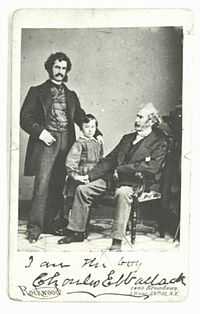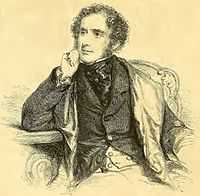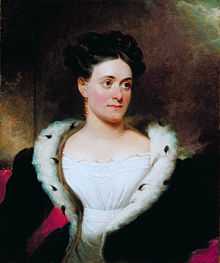James William Wallack


James William Wallack (c. 1794–1864) was an Anglo-American actor and manager, born in London, and brother of Henry John Wallack.
Life
Wallack's parents were comedians, who performed at the London minor playhouses and in the British provinces. His first appearance on the stage was as a child at the Surrey Theatre in London. Soon afterward he performed in juvenile characters at Drury Lane, and at the age of eighteen entered on a permanent career at the same house as Laertes in Hamlet. He also acted in the British provinces and in Ireland, gradually winning his way to popularity as a useful representative of drama and comedy. In 1824 Wallack became stage manager at Drury Lane, and rose to the performance of secondary roles in tragedy. Later he played at the Haymarket Theatre, and officiated as stage manager at the Princess's Theatre.[1]
On the occasion of his first visit to the United States, in 1818, he played Macbeth at the Park Theatre, New York. He also played Romeo, Shylock, Coriolanus, Hamlet, and Richard III, all without making any favorable impression. But in the principal roles in The Stranger, Pizarro and The Gamester he closely copied the manner of Kemble and attracted favorable consideration. From 1818 until 1845 Wallack performed at intervals in all the principal cities of the United States. Among his roles were the chief characters in The Brigand, The Rent-Day, The Wonder, Don Cassar de Bazan, Wild Oats and the refined comedy parts of Mercutio, Jaques, and Benedick. Love's Ritornello, as sung by him in The Brigand, was hummed from one end of the country to the other.[2]
In 1822 Wallack met with an accident, in which his leg was fractured by the overturning of a stagecoach between New York and Philadelphia. This mishap retired him from active life for about eighteen months, and from its effect he never entirely recovered. From 1837 until its destruction by fire, Wallack conducted the New York National Theatre.[3] There he presented a repertory of the best plays in the English language, rendered by a company such as never before had been seen in this country.[4]
He settled permanently in New York City in 1852.[5] In that year, he assumed management of an 1850 theatre two doors south of Broome Street on the west side of Broadway, called Brougham's Lyceum, renaming it Wallack's Lyceum.[6] In 1861 he built a new Wallack's Theatre at 13th Street and Broadway.[7][8] His son opened the third Wallack's Theatre in 1882.[9]
Wallack was an actor of the old school. Thackeray praised his performance as Shylock, and Joseph Jefferson his Don Caesar de Bazan.[10] As a performer he was endowed with a fine personality; his voice was highly melodious, set off by flexibility and careful elocution, and his knowledge of stage-effect was unexcelled. In refined and eccentric comedy Wallack had few superiors. Some of his roles in the romantic dramas of his own creation were entirely unequalled, and have died with him.[11]

He married the daughter of John Henry Johnstone (1749–1828), a popular tenor and stage Irishman; she died in 1851. Their son, Lester Wallack, was also a famous actor and theater manager.[12]
References
Notes
Sources
- (Appletons') Weidemeyer, John William "Wallack, James William" in Wilson, James Grant and Fiske, John (eds.) Appletons' Cyclopædia of American Biography volume vi. (New York: D. Appleton and Company, 1889) p. 336f. Online at Google Books. Also online in pdf at Internet Archive.
- Brown, Thomas Allston A History of the New York Stage, volume i. (New York: Dodd, Mead and Company; 1903) pp. 23-4, 36, 47 (on the Park Theatre) and p. 243f (on the National Theatre).
- (Encyclopædia Britannica) "Wallack, James William" in Chisholm, Hugh (ed.) Encyclopædia Britannica (11th ed.) volume xxviii. (Cambridge: University Press, 1911) p. 279. Also online at Internet Archive.
- Ireland, Joseph N. Records of the New York Stage from 1750 to 1860, volume i. (T. H. Morrell, New York, 1867), pp. 341f and 396f.
- “James W. Wallack,” Gleason’s Pictorial Drawing Room Companion, Vol. 3 No. 22 (November 27, 1852) p. 344
- Knight, John Joseph "Wallack, James William" in Lee, Sidney (ed.) Dictionary of National Biography volume lix (London: Smith, Elder, & Co.; 1899) p. 117f. Also online at Internet Archive.
- A Sketch of the Life of James William Wallack: (senior,) Late Actor and Manager [compiled by the publisher] (T. H. Morrell, New York, 1865) described in Bibliotheca dramatica et curiosa, p. 362
- Wallack, Lester and Hutton, Laurence Memories of Fifty Years. (Charles Scribner's Sons, New York, 1889)
- Winter, William, The Wallet of Time, volume i. (Moffat, Yard and Company, New York, 1913)